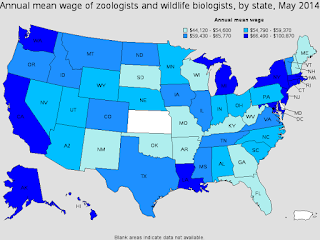Field Research:
Field research is conducted outside of a laboratory and the areas could vary. For example, field research could take place in the middle of the woods or in a residence hall within a University. With field research the researcher gets a better understanding of the environment and the interactions that are taking place within. This type of research "offers contextual data on settings, interactions, or individuals". Because you are observing the behavior of animals your data could be misrepresented because of atypical behavior within a group of animals. This could be a single goose flying 50 yards to the right of the standard V formation. The way you gather information is with your field notes on your observations. You can also use videos or pictures to capture the behaviors of animals. We use both of these in my Fisheries and Wildlife lab class. Field research isn't always the best option because it takes up a ton of time and money. It takes time for a person to become familiarized with an area and the populations within said area.
If you enjoy hands on experience and learn through doing the field is where you should be. I personally enjoy field research better than the lab because you get to experience nature while doing it. Id love to be the person who sticks their face into the water to look for snails or doing a pebble count or whatever they are doing in the picture above.
"Field Research." Field Research. Child Care and Early Education Research Connections. Web. 31 Oct. 2015.
Lab Research:
The definition of lab research is research that is done in a room that is fit for scientific experiments. A benefit of lab research is the fact that it is conducted in a controlled environment. A person can manipulate variables and observe the reactions. This is beneficial because you don't have to spend a lot of time trying to familiarize yourself with a place. In my LB 144 class my group is working with pond snails. If we were to do field research we would have to spend most of our time in a body of water looking for snails the size of a pea. If you are crunched for time lab research is the way to go in my opinion. It takes out environmental variation and makes your experiment more accurate.
Jake B.
Field research is conducted outside of a laboratory and the areas could vary. For example, field research could take place in the middle of the woods or in a residence hall within a University. With field research the researcher gets a better understanding of the environment and the interactions that are taking place within. This type of research "offers contextual data on settings, interactions, or individuals". Because you are observing the behavior of animals your data could be misrepresented because of atypical behavior within a group of animals. This could be a single goose flying 50 yards to the right of the standard V formation. The way you gather information is with your field notes on your observations. You can also use videos or pictures to capture the behaviors of animals. We use both of these in my Fisheries and Wildlife lab class. Field research isn't always the best option because it takes up a ton of time and money. It takes time for a person to become familiarized with an area and the populations within said area.
"Field Research." Field Research. Child Care and Early Education Research Connections. Web. 31 Oct. 2015.
Lab Research:
The definition of lab research is research that is done in a room that is fit for scientific experiments. A benefit of lab research is the fact that it is conducted in a controlled environment. A person can manipulate variables and observe the reactions. This is beneficial because you don't have to spend a lot of time trying to familiarize yourself with a place. In my LB 144 class my group is working with pond snails. If we were to do field research we would have to spend most of our time in a body of water looking for snails the size of a pea. If you are crunched for time lab research is the way to go in my opinion. It takes out environmental variation and makes your experiment more accurate.
Jake B.






























